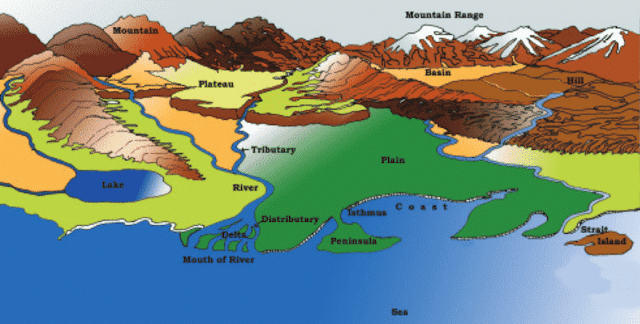 |
| Major Landforms of the Earth |
Landforms are the result of two processes: Internal Process and External Process.
Internal Process: Within the earth surface, there is a continuous movement of earth plates. This internal movement leads to the upliftment and sinking of the earth surface at several points. Thereby, the process of making of earth surface is known as the internal process.
External Process: The continuous process of wearing and tearing down of earth surface by activities such as erosion and deposition is known as the external process.
On the basis of elevation and slope, we can group landforms into mountains, plateaus and plains.
Mountains
- Mountains are the natural elevation of the earth. They are marked by a summit and a broad base.
- In some mountains, there permanently frozen streams of ice, these are frozen streams known as glaciers.
- Some mountains are even higher than they visible as they are submerged in the sea. Mount Kea (Hawaii) is one such example. At 10,203 meters, Mount Kea is the tallest mountain on earth if measured from Oceanic base.
- If arranged in a line, mountains form a range.
- The Himalaya (Asia), The Alps (Europe) and The Andes (South America) are some of the most prominent mountain ranges in the world.
- There are three types of the mountain: 1. Fold Mountain, 2. Block Mountain and 3. Volcanic Mountain.
- Mountains are the storehouse of water. Many rivers have their origin in the mountains.
- The water from the mountain with the help of technology is used for irrigation and power generation.
- The river valleys are ideal for crop cultivation.
- Mountains are home to a rich variety of fauna and flora.
Fold Mountains
The Himalaya and the Alps are the examples of young fold mountains whereas as the Aravali, the Appalachians (North America) and the Ural (Russia) are the examples of old fold mountains.
Block Mountains
The block mountains created when a large area of earth is broken and displaced vertically. The uplifted block is known as a horst and depressed section is known as graben. Narmada river valley, the Rhine valley, the Vosges mountain are prime examples of this type of mountains.
Volcanic Mountains
Volcanic mountains are formed due to volcanic activities. Mount Kilimanjaro of Africa and Mount Fujiyama of Japan are prime examples of such mountains.
- A plateau is an elevated flat table land standing above the surrounding. It has one or more sites of steep slopes.
- The Deccan Plateau (India), the East African Plateau (Africa), the Western Plateau (Australia) and the Tibet Plateau (Tibet, China) are some of the prominent examples of plateaus on earth.
- The Tibet Plateau is the highest plateau on the earth with an average height ranging from 4000 to 6000 meters.
- Plateaus have rich mineral deposits. The African Plateau is known for gold and diamond mining. Similarly, Chhotanagpur plateau is known for its rich coal, iron and manganese ore deposits.
- Several waterfalls can be spotted on plateaus. Hundru falls on Subarnekha river in Chhotanagpur plateau and Jog falls in Karnataka are some of the examples of this phenomena.
Plains
- Plains are the large stretches of flat land. Generally, their elevation is less than 200 meters above sea level.
- The plains are mostly formed by the action of rivers. The rivers flow through mountain slopes while eroding them a bit. They carry the eroded materials consisting of stones, sand and silt and deposit them throughout their course in their valleys. This deposit leads to the formation of plains.
- Plains are fertile in nature, which make them suitable for agriculture.
- Plains are the most populated regions in the world as it is easy to construct housing, industry and roads on them.
- Ganga and Brahmaputra in India, Yangtze in China and River Nile floodplains are some of the prominent examples.
